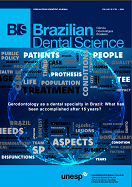Endodontic treatment of maxillary lateral incisor with internal root resorption using a hybrid instrumentation technique - case report
DOI:
https://doi.org/10.14295/bds.2016.v19i2.1159Abstract
Several factors influence the cleaning and shaping capacity of instrumentation techniques, such as internal resorption areas. Internal root resorption contributes to failure of endodontic treatment, since debris may remain attached to dentine walls, and the instruments are not able to completely remove them. This paper reports a clinical case of endodontic treatment of a tooth with internal root resorption using a hybrid instrumentation technique. After clinical and radiographic examinations, pulp necrosis with periapical lesion, and the presence of an internal root resorption were diagnosed. Biomechanical preparation began with glide path creation with sizes 15 and 20 K-type files. Apical third instrumentation was performed with rotary ProFile files #25.04 up to #35.04, followed by root canal filling. The case was followed-up for twelve months. Progressive bone repair was observed radiographically. Despite the presence of internal root resorption, the results achieved with the hybrid technique suggest effectiveness in this clinical case solution.
Keywords: Dental Pulp Cavity; Endodontics; Root canal therapy.
Downloads
Downloads
Additional Files
Published
How to Cite
Issue
Section
License
Brazilian Dental Science uses the Creative Commons (CC-BY 4.0) license, thus preserving the integrity of articles in an open access environment. The journal allows the author to retain publishing rights without restrictions.
=================




























